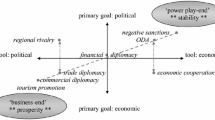Abstract
This volume attempts to present how Japanese and Russian academics portray and analyze the domestic politics and foreign policy of the two countries in the 2010s. In an era of globalization, Seymore Martin Lipset1 is most apt when he says that one never knows one country without knowing other countries. A foremost scholar specializing in and well-versed with one country cannot automatically be a scholar in the Lipset sense. When “socialism in one country” was a good slogan for Russia during much of the Soviet period (1917–1991) and when the Economic Planning Agency drew Japan’s “national economic outlook” in much of the preglobalization era (before 1985–), knowing one country was almost enough for country specialists—a starkly different feat in the 2010s.
Financial support from the Nomura Foundation and the University of Niigata Prefecture is gratefully acknowledged.
Access this chapter
Tax calculation will be finalised at checkout
Purchases are for personal use only
Preview
Unable to display preview. Download preview PDF.
Similar content being viewed by others
Notes
Martin Lipset, Political Man: The Social Bases of Politics (New York: Doubledday Publishing, 1960).
Alexander Gershenkron, Economic Backwardness in Historical Perspective, (Cambridge: Belknap Press of Harvard University Press, 1962).
Ronald Dore, British Factory-Japanese Factory: The Origins of National Diversity in Industrial Relations, With a New Afterword (Oakland: University of California Press, 1973).
Jeremy Adelman, eds., Worldly Philosopher. The Odyssey of Albert O. Hirschman (Princeton, NJ: Princeton University Press, 2013).
T. J. Pempel, Uncommon Democracies: The One Party Dominant Regimes (Ithaca, NY: Cornell University Press, 1990).
Alexander Gershenkron, Economic Backwardness in Historical Perspective (Cambridge: Belknap Press of Harvard University Press, 1962);
Emmanuel Todd disputes this thesis, says that Japan had never been late vis-à-vis Europe. Citing S. B. Hanley and Kozo Yamamura’s Economic and Demographic Change in Preindustrial Japan, 1600–1868 (Princeton, NJ: Princeton University Press 1978).
Todd argues that Japan and Europe kept demographic equilibrium and anthropological constancy in terms of the age for first marriage of the female population. Japanese demographic data (Hanley and Yamamura 1977) show that during 1680 and 1975 in Tokugawa, Japan, a female’s first marriage took place when she was 21 to 24 years old. On this point, Todd may as well say that Japanese went ahead of Europeans in terms of achieving demographic equilibrium and anghropological constancy; (Emmanuel Todd, Sekai noTayosei: Kazoku Kozo to Kindaisei (La diversité du monde: Structures familiales et modernité) (Tokyo: Fujiwara Shoten, 2013), 393.
Junnosuke Masumi, Nihon Seitoshiron (Treatise on Political Parties in Japan), 8 revised volumes (Tokyo: University of Tokyo Press, 2011);
Harukata Takenaka, Failed Democratization in Perwar Japan (Stanford, CA: Stanford University Press, 2014).
Peter Gourevitch, Takashi Inoguchi, and Courtney Purrington, eds., United States-Japan Relations and International Institutions after the Cold War (San Diego: University of California Graduate School of International Relations and Pacific Studies, 1995).
Dmitri Trenin, Post-Imperium: A Eurasian Story (Washington, DC: Carnegie Endowment for International Peace, 2011).
Alena Ledeneva, Can Russia Modernize? Sistema, Power Networks and Informal Governance (Cambridge: Cambridge University Press, 2013);
Ben Judah, Fragile Empire: How Russia Fell in and out of Love with Vladimir Putin (New Haven, CT: Yale University Press, 2013).
Author information
Authors and Affiliations
Editor information
Editors and Affiliations
Copyright information
© 2015 Takashi Inoguchi
About this chapter
Cite this chapter
Inoguchi, T. (2015). Japan and Russia: Domestic Politics and Foreign Policy. In: Inoguchi, T. (eds) Japanese and Russian Politics. Palgrave Macmillan, New York. https://doi.org/10.1057/9781137488459_1
Download citation
DOI: https://doi.org/10.1057/9781137488459_1
Publisher Name: Palgrave Macmillan, New York
Print ISBN: 978-1-349-50410-7
Online ISBN: 978-1-137-48845-9
eBook Packages: Palgrave Intern. Relations & Development CollectionPolitical Science and International Studies (R0)




